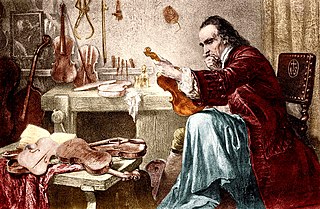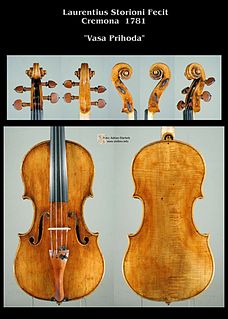Related Research Articles

A lute is any plucked string instrument with a neck and a deep round back enclosing a hollow cavity, usually with a sound hole or opening in the body. It may be either fretted or unfretted.

The violin, sometimes known as a fiddle, is a wooden chordophone in the violin family. Most violins have a hollow wooden body. It is the smallest and thus highest-pitched instrument (soprano) in the family in regular use. The violin typically has four strings, usually tuned in perfect fifths with notes G3, D4, A4, E5, and is most commonly played by drawing a bow across its strings. It can also be played by plucking the strings with the fingers (pizzicato) and, in specialized cases, by striking the strings with the wooden side of the bow.

The viola ( vee-OH-lə, alsovy-OH-lə, Italian: [ˈvjɔːla, viˈɔːla]) is a string instrument that is bowed, plucked, or played with varying techniques. It is slightly larger than a violin and has a lower and deeper sound. Since the 18th century, it has been the middle or alto voice of the violin family, between the violin (which is tuned a perfect fifth above) and the cello (which is tuned an octave below). The strings from low to high are typically tuned to C3, G3, D4, and A4.

The viol, viola da gamba, or informally gamba, is any one of a family of bowed, fretted and stringed instruments with hollow wooden bodies and pegboxes where the tension on the strings can be increased or decreased to adjust the pitch of each of the strings. Frets on the viol are usually made of gut, tied on the fingerboard around the instrument's neck, to enable the performer to stop the strings more cleanly. Frets improve consistency of intonation and lend the stopped notes a tone that better matches the open strings. Viols first appeared in Spain in the mid to late 15th century and were most popular in the Renaissance and Baroque (1600–1750) periods. Early ancestors include the Arabic rebab and the medieval European vielle, but later, more direct possible ancestors include the Venetian viole and the 15th- and 16th-century Spanish vihuela, a 6-course plucked instrument tuned like a lute that looked like but was quite distinct from the 4-course guitar.

Antonio Stradivari was an Italian luthier and a craftsman of string instruments such as violins, cellos, guitars, violas and harps. The Latinized form of his surname, Stradivarius, as well as the colloquial Strad are terms often used to refer to his instruments. It is estimated that Stradivari produced 1,116 instruments, of which 960 were violins. Around 650 instruments survived, including 450 to 512 violins.

Chamber music is a form of classical music that is composed for a small group of instruments—traditionally a group that could fit in a palace chamber or a large room. Most broadly, it includes any art music that is performed by a small number of performers, with one performer to a part. However, by convention, it usually does not include solo instrument performances.

Milton Byron Babbitt was an American composer, music theorist, mathematician, and teacher. He is particularly noted for his serial and electronic music.
In music, a bow is a tensioned stick which has hair coated in rosin affixed to it. It is moved across some part of a musical instrument to cause vibration, which the instrument emits as sound. The vast majority of bows are used with string instruments, such as the violin, although some bows are used with musical saws and other bowed idiophones.

The sonatas and partitas for solo violin are a set of six works composed by Johann Sebastian Bach. They are sometimes referred to in English as the sonatas and partias for solo violin in accordance with Bach's headings in the autograph manuscript: "Partia" was commonly used in German-speaking regions during Bach's time, whereas the Italian "partita" was introduced to this set in the 1879 Bach Gesellschaft edition, having become standard by that time. The set consists of three sonatas da chiesa in four movements and three partitas in dance-form movements. The 2nd Partita is widely known for its Chaconne, considered one of the most masterly and expressive works ever written for solo violin.
Joshua Rifkin is an American conductor, keyboard player, and musicologist, currently a Professor of Music at Boston University. As a performer he has recorded music by composers from Antoine Busnois to Silvestre Revueltas, and as a scholar has published research on composers from the Renaissance to the 20th century. He is famed among classical musicians and aficionados for his increasingly influential theory that most of Bach's choral works were sung with only one singer per choral line. Rifkin argued: "So long as we define 'chorus' in the conventional modern sense, then Bach's chorus, with few exceptions, simply did not exist." He is best known by the general public, however, for having played a central role in the ragtime revival in the 1970s, with the three albums he recorded of Scott Joplin's works for Nonesuch Records.

Bartolomeo Giuseppe "del Gesù" Guarneri was an Italian luthier from the Guarneri family of Cremona. He rivals Antonio Stradivari (1644–1737) with regard to the respect and reverence accorded his instruments, and for many prominent players and collectors his instruments are the most coveted of all. Instruments made by Guarneri are often referred to as Del Gesùs.
Samuel Zygmuntowicz is an award-winning contemporary luthier. He began his instrument making training at age 13, and studied making and restoration under Peter Prier, Carl Becker and René Morel. Since 1985 he has been based in Brooklyn, New York. His early work demonstrates expert skill as a copyist of classic instruments. Later work includes personal models informed by intensive advanced research. Findings from this research have been published in numerous print and digital media. Zygmuntowicz is an active fiddler, playing with several folk music groups. His playing can be heard on the recordings Grand Picnic, and Jump When the Trumpets Blow.

Peter Watchorn is an Australian-born harpsichordist who has combined a virtuosic keyboard technique, musical scholarship and practical experience in the construction of harpsichords copied from original instruments of the 17th and 18th centuries. As well as presenting many solo public performances and broadcasts of baroque keyboard music and participating in choral and orchestral performances, he has made numerous commercial CD recordings of solo harpsichord music from the 17th and 18th centuries. He specialises in the music of J. S. Bach, 17th-century French and German music, and the works of the English virginalist composers. He is widely recognised as an expert on the history of the early music revival during the 20th century. His biography of the Viennese harpsichordist Isolde Ahlgrimm (1914–95) was published by Ashgate in December 2007.
Stephanie Ann Chase is an American classical violinist.
Stewart Pollens is an expert on historical musical instruments. His work includes restoration, analysis, and scholarly publication; and it embraces keyboard instruments as well as historical stringed instruments such as the violin and cello. Andrew Manze has called him "one of the world’s foremost authorities on musical instruments."

Lorenzo Storioni is considered one of the last of the classic Cremonese master violin makers/luthiers of the 18th century.
Keith Richard Hill is a prize winning American maker of musical instruments He has conducted research into the acoustical technology employed by musical instrument makers from 1550–1850, and used this knowledge to create hundreds of harpsichords, clavichords and other instruments.
The voice flute (also the Italian flauto di voce and the French flûte de voix are found in English-language sources) is a recorder with the lowest note of D4, and is therefore intermediate in size between the alto and tenor recorders.

Benning Violins is a California-based luthier business, crafting, restoring and repairing violins, violas and cellos since its opening in 1950 as Studio City Music. In 1953, it moved to its current location on Ventura Boulevard. Learning the craft from his brother-in-law, Carl Becker Sr., Paul Toenniges worked in William Lewis & Son in Chicago, and later under Rudolf Wurlitzer, finally opening his first studio in Los Angeles. Crafting up to five instruments a year, they sell for approximately 30-42 thousand dollars.
Daniel Robert Waitzman is an American flutist and composer.
References
Brattleboro Reformer, January 19–20, 2008 Photo Journal, “King of String”
Brattleboro Reformer, October 24, 2008 “Local violin maker recognized by Windham County Arts Council”
Northern Woodlands Magazine, Winter 2002 “Sonatas in Spruce; Minuets in Maple”
The Deerfield Valley News, July 23, 1997 “Work is music to violin maker’s ears”